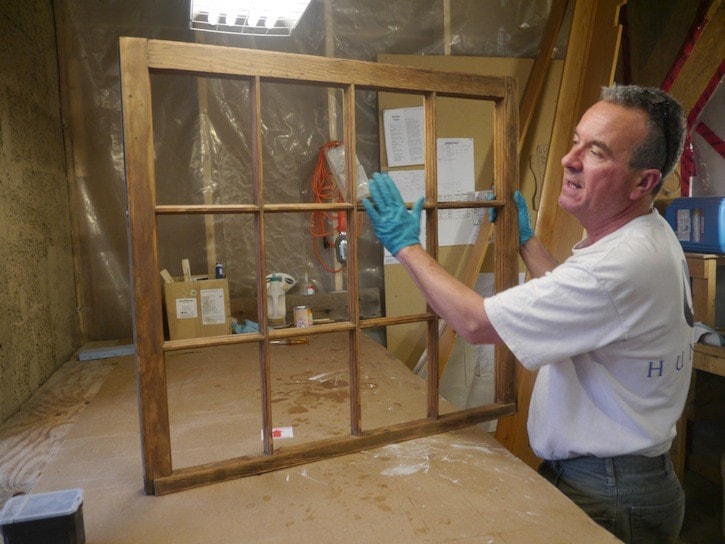Windows from Bill Metcalfe on Vimeo.
Anton Horvath is restoring 56 heritage windows, and it’s a complex job. Built and installed in the old CPR station in 1900, the windows have been painted with lead-based paint many times.
“We start with stripping them,” says Horvath. “We use hot guns, and there is lead paint on them so you have to use a respirator. For the next stage, you put them in a steamer that we built.”
The steamer is to soften the glazing so Horvath can take out the glass panes and save them. Some of the windows have multiple small panes, so it can be a lot of work.
Then he sands the windows, with machines and by hand, and cleans them using sandpaper, steel wool, and an alcohol based cleaner.
Once the original wood is exposed and smooth, Horvath puts shellac on the inside of the window frame, then puts the glass back in, and then puts linseed oil on the outside of the frames.
When the windows are re-installed, another modern glass pane will be installed inside them, to provide double glazing for the extremely high insulation values the whole building is aiming for.

Old-fashioned, sustainable finishes
Shellac and linseed oil are both old-time finishes. They take more coats and more drying time than modern finishes, but their presence here says a lot about the authenticity of the restoration of the building.
“Ironically we are on the cusp of something that everybody talks about: sustainability and green building,” says Joern Wingender, the contractor overseeing the restoration. “The finishes you buy in the hardware store are petroleum based.”
Linseed oil is derived from flax, and shellac is a resin secreted by a bug on trees in India and Thailand, mixed with ethanol.
“Bringing the project in sync with nature,” he says. “This is ecosystem-based architecture.”
Living up to heritage standards
The CPR station has a federal heritage designation for railway stations, and the heritage registry recognizes three components of this station that need to be preserved: the windows, the upper canopy, and the siding.
“I am often asked why we don’t chuck out the windows and put vinyl windows in because it would be cheaper,” says Wingender. But if you do that, you lose the significance of the building. This is about asking where we come from, and what we have done in the past, and what we want to do in the future.”
Tom Thomson is the executive director of the chamber of commerce, which initiated, and is constantly fundraising for, the restoration.
“That building could have been knocked down and replicated for two-thirds the cost,” he says. “Some people thought we were acquiring an asset, some thought a liability.
“It fits the reputation of Nelson for heritage buildings,” Thomson says. “We wanted to set an example to other building owners and developers: here is an example of how to maintain heritage buildings.”

“They knew what they were doing”
Wingender explains how the original windows were made with old-growth lumber, which has the straight grain and stability that most carpenters never see any more.
“The people who built those windows knew what they were doing, and knew the material. All windows on the upper floor, exposed heavily to the weather, their main sashes are made of fir, but the bottom style pieces on each one are made of larch, the pitchiest larch you can find. Someone in the manufacturing of those windows knew how nature works.”
He explains that larch is much more rot resistant than pine or spruce and will last as long as a chemically treated piece of wood, and that the makers used larch for the bottom piece of the window sash where it is most exposed to the weather and tends to rot first.
Relearning everything
“People knew how to go about it, and we are relearning everything. That is why we are going through this process of training people. The way backwards is the way forward.”
One of the people trained at the CPR station in these kinds of restoration skills is Anton Horvath. A house painter by trade, he has been trained at the CPR station as a restorer by Wingender and by visiting consultant Kate Richardson.
“It is interesting because it is an old technique,” says Horvath. “You learn a lot. There are stages that you might not like, like stripping because you have to wear a respirator. But finishing is the best, and shellacking is pleasant to do. You see the difference. It is an art.”
Photos by Bill Metcalfe
